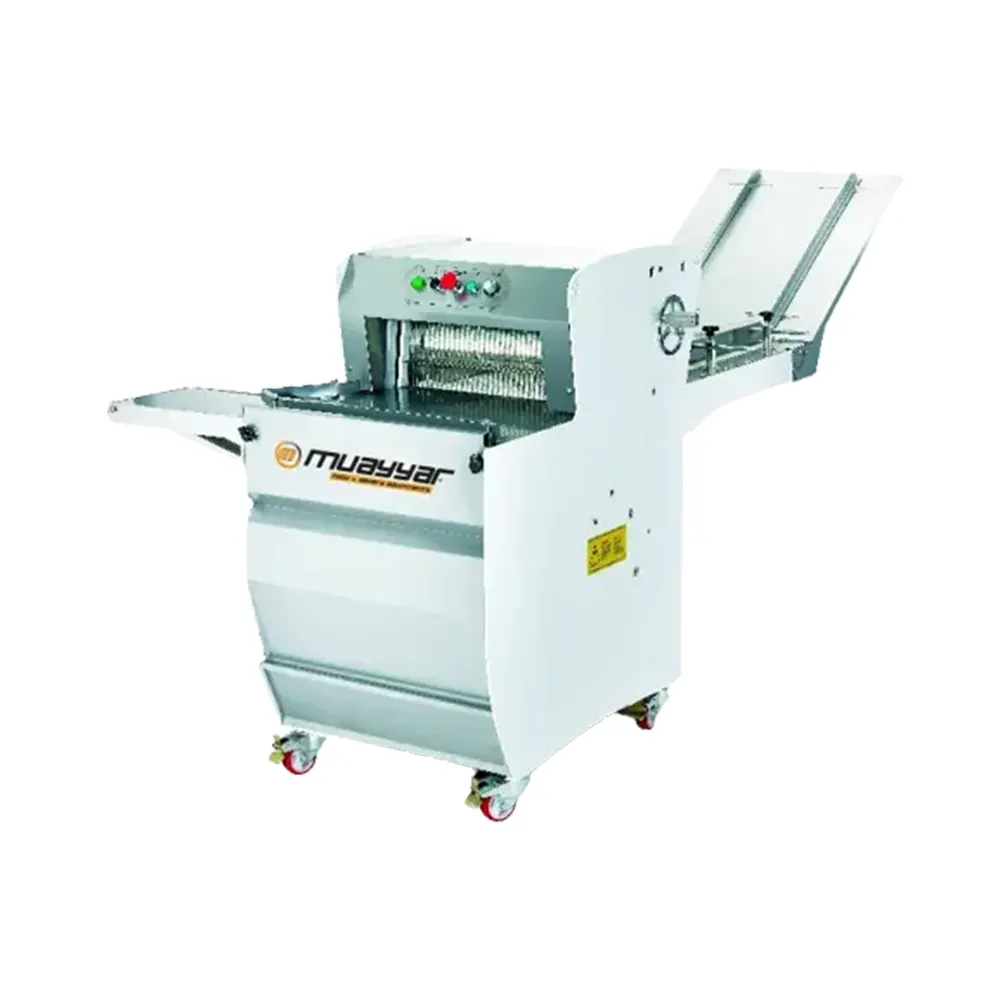Bread Slicing Machine Detalied Technical Specifications
| Model | Unit | MEDM 30 | MEDM 31 |
| Capacity | pieces/hour | 500 | 500 |
| Thickness of Slice | 8-20 | 8-20 | |
| Table Height | mm | 760 | 250 |
| Max Bread Length | mm | 450 | 380 |
| Max Bread Height | mm | 180 | 150 |
| Min Bread Height | mm | 50 | 50 |
| Width | mm | 650 | 650 |
| Length | mm | 820 | 650 |
| Electrical power (220V/380V) | kW | 0.37 | 0.37 |
| Weight of machine | kg | 150 | 120 |
This machine is used for slicing of all types of bread thickness. All bread toughing surface and knives are made of stainless steel. And main body electrostatically painted. At the end of slicing process, machine stops automatically. Easy to use, no maintenance, easy cleaning and small size. Manufactured as single-phase or three-phase motor power (220V or 380V / 50Hz)
In the bustling realm of bakery operations, precision and efficiency are paramount. One of the crucial processes in bread production is slicing, a task that has evolved from manual labor to automated precision with the advent of bread slicing machines. These machines not only streamline production but also ensure uniformity and consistency in slice thickness, catering to the diverse needs of bakeries and consumers alike.
Evolution of Bread Slicing Machines: Historically, bread slicing was a labor-intensive task performed manually, often resulting in irregular slice thickness and inconsistencies. However, the introduction of automated bread slicing machines revolutionized this process, offering precise slicing capabilities that enhance product quality and efficiency.
Early bread slicing machines were simple in design, featuring rotating blades or guillotine-like mechanisms to cut bread loaves into slices. Over time, technological advancements led to the development of sophisticated slicing machines equipped with precision controls, multiple blades, and customization options to meet the specific requirements of bakeries.
Key Features and Components: Modern bread slicing machines boast an array of features designed to optimize efficiency and quality. These machines typically consist of the following components:
- Conveyor System: Automated systems for transporting bread loaves into the slicing unit.
- Blade Assembly: High-precision blades capable of slicing bread loaves with consistent thickness.
- Adjustable Settings: Controls for adjusting slice thickness to meet varying customer preferences.
- Safety Features: Mechanisms to ensure operator safety during machine operation, such as blade guards and emergency stop buttons.
- Cleaning Mechanism: Easy-to-clean components to maintain hygiene standards and prevent cross-contamination.
- Customization Options: Settings for adjusting slicing speed, loaf positioning, and blade configurations to accommodate different bread types and sizes.
Types of Bread Slicing Machines: Bread slicing machines come in various types to cater to different bakery sizes and production volumes:
- Automatic Bread Slicing Machines: Fully automated systems capable of slicing large volumes of bread with minimal human intervention, ideal for industrial-scale bakeries.
- Semi-Automatic Bread Slicers: Suitable for medium-sized bakeries, these machines require some manual input for loaf placement and removal but offer automated slicing capabilities.
- Tabletop Bread Slicers: Compact machines designed for small bakeries or specialty bread producers, offering basic slicing functionalities with manual operation.
Benefits of Bread Slicing Machines: The adoption of bread slicing machines brings numerous benefits to bakery operations:
- Precision and Consistency: Automated slicing ensures uniform slice thickness, enhancing product presentation and consumer satisfaction.
- Increased Efficiency: Streamlined production processes reduce manual labor and save time, allowing bakeries to meet demand more effectively.
- Versatility: Adjustable settings accommodate various bread types, sizes, and slice thickness preferences, catering to diverse customer needs.
- Reduced Waste: Precision slicing minimizes wastage by optimizing the use of bread loaves, contributing to cost savings and sustainability efforts.
- Hygiene and Safety: Easy-to-clean components and safety features promote hygiene and prevent accidents, ensuring compliance with food safety regulations.
Challenges and Considerations: Despite their advantages, bread slicing machines pose certain challenges and considerations:
- Initial Investment: The cost of purchasing and installing advanced slicing equipment can be significant, particularly for smaller bakeries.
- Maintenance Requirements: Regular maintenance and cleaning are essential to ensure optimal performance and hygiene, requiring dedicated resources and time.
- Operator Training: Operators need training to operate and maintain the machinery effectively, minimizing errors and downtime.
- Adaptability: Machines should be adaptable to accommodate different bread types and sizes, requiring flexible blade configurations and settings.
Conclusion: Bread slicing machines represent a technological marvel in the bakery industry, offering precision, efficiency, and versatility in the slicing process. From automated systems for industrial-scale production to compact tabletop slicers for small bakeries, these machines cater to diverse needs while ensuring consistent slice thickness and product quality. Despite initial investment and operational considerations, the long-term benefits of enhanced efficiency, reduced waste, and improved product presentation justify the adoption of these advanced slicing solutions, empowering bakeries to thrive in a competitive market landscape.


Reviews
There are no reviews yet.